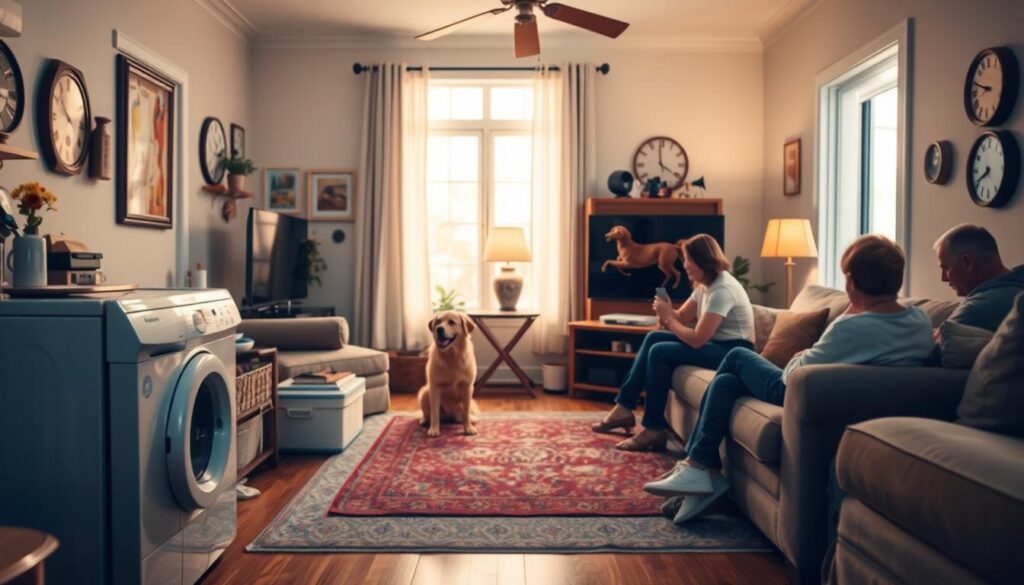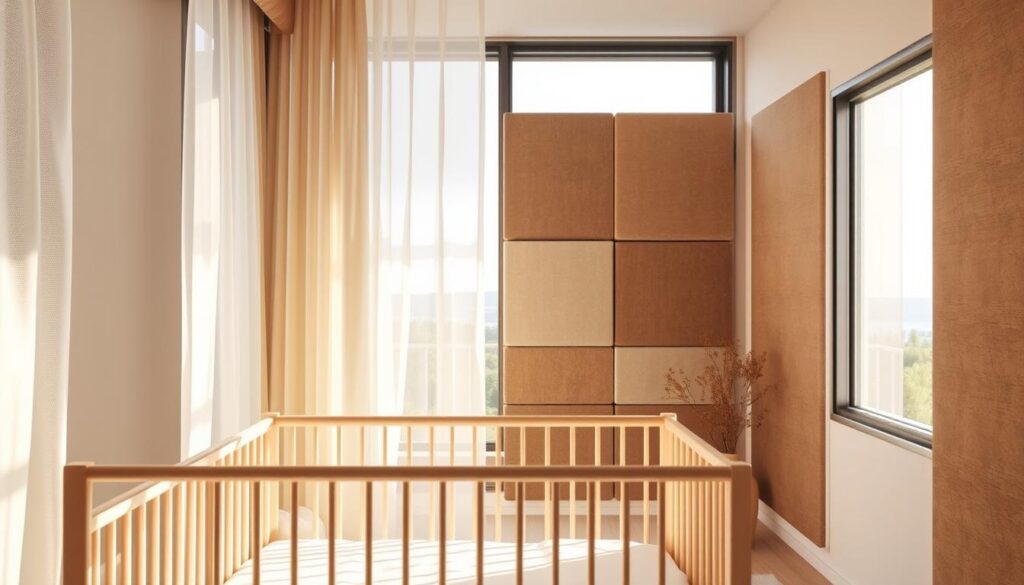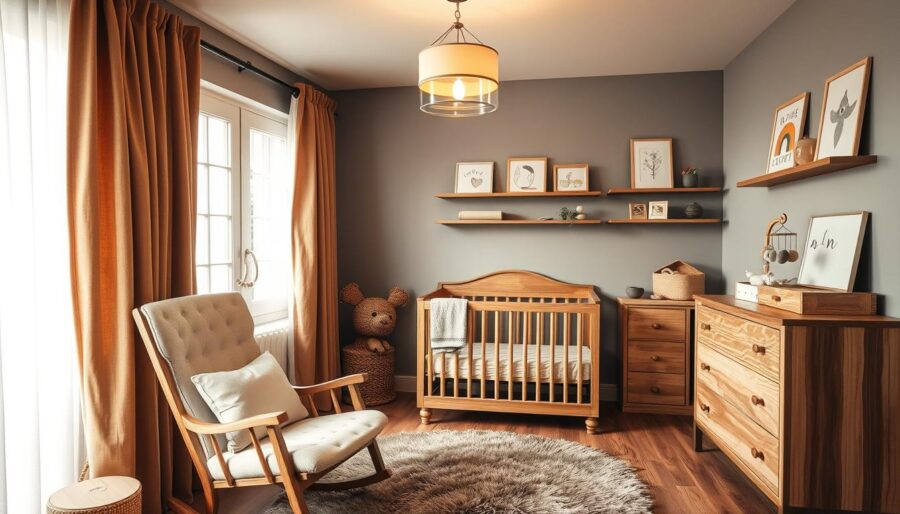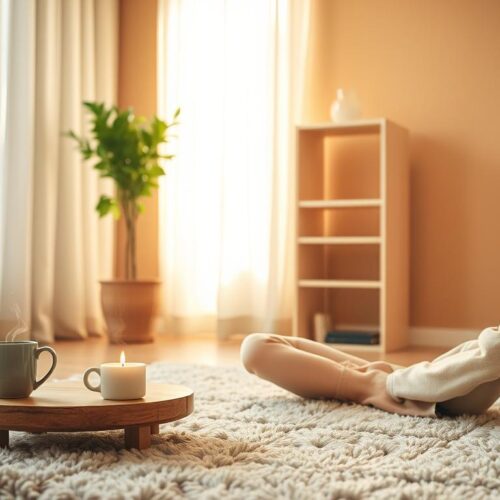Making your home quiet is key for your baby’s growth and happiness. Lowering noise helps avoid problems with hearing and can prevent delays in learning for little ones. A peaceful place to live helps everyone sleep better and feel mentally stronger, and it’s important when designing your home.
Understanding Acoustic Comfort in Your Home
Acoustic comfort in your home is vital for a peaceful setting, especially if you have babies. It helps lower stress, improves sleep, and aids kids’ speech and language growth.
A home with thoughtfully designed acoustics keeps noise under 40 dB. This makes for a productive and healthy living space. For homes with babies, managing noise is key to their comfort and uninterrupted sleep.
Reducing background noise is a big concern in indoor acoustics. Sounds like appliance hums or traffic noise can disrupt your home’s peace. By making a balanced acoustic setting, you get a calm place for rest and wellness.
In short, the right acoustic setup turns your home into a haven. Paying attention to noise levels and acoustic design ensures everyone’s comfort and a better life quality.
The Science Behind Sound and Its Impact
Understanding how sound affects us needs a basic grasp of acoustic science. Sound moves in waves and can greatly impact our health. Being surrounded by too much noise can really affect how we feel, sleep, and our overall health. The shows that too much noise can make our heart rates go up. This is especially true for kids, making them more easily upset and less patient.
Noise doesn’t just affect our bodies, it also affects our minds. If the noise level keeps changing, it can make it hard for us to focus and be productive. Learning about soundproofing can help lessen these negative impacts. Putting in measures to soundproof can make our living spaces better and improve our health.
Identifying Sources of Noise in Your Home
Finding out what makes noise at home is key to making your baby more comfortable. Noise can come from both inside and outside your house. This noise affects how peaceful your home is.
Common home noise sources include:
- Household appliances such as dishwashers, washing machines, and HVAC systems.
- External noises from traffic, especially in cities.
- Noisy neighbors or shared living spaces with thin walls.
Start reducing noise by figuring out where it comes from. Note down the loudest times and places in your home.

To cut down on noise, check where it’s coming from. Putting soft things around your home can help quiet sounds. Buying quiet furniture or rugs can also make your baby more comfortable. Plus, doing loud chores when your baby is awake helps.
Making your home quieter is great for your baby’s comfort and makes your home more peaceful for everyone.
Designing Quiet Spaces for Your Baby
Creating an optimal *baby sleep environment* requires careful thought. One key point is where your baby’s room is. It should be away from busy areas like the living room or kitchen. This makes sure your baby isn’t disturbed easily.
To cut down noise, use materials that absorb sound. Thick rugs, heavy drapes, and panels help a lot. Also, arranging furniture like bookshelves against walls blocks noise. This creates a peaceful place for your baby to sleep.
For a calm space, choose soft colors and minimal decorations. Bright colors and too much decor can overstimulate your baby. Soft colors and fewer items help your baby sleep well and grow mentally and emotionally.
Keep your baby’s room at a steady warmth and humidity. Soft sounds, like from a white noise machine, can hide sudden noises. This helps keep the room quiet and comforting.
To wrap up, creating a nurturing *baby sleep environment* is important. Focusing on where to place the room, using sound-absorbing items, and a calm setting helps your baby sleep and grow. This is how you make a peaceful room for your baby.
Selecting the Best Materials for Acoustic Comfort
Creating a calm space for your baby means picking the right soundproofing stuff. These choices make inside sounds better, turning your place into a quiet retreat. For carpet noise cut-down, try danfloor carpets. They are good at soaking up sound, fighting germs, and they last long.
Don’t forget about curtains for soundproofing. Thick ones can block a lot of noise from outside. They work great for making indoors sound nicer. And, soundproofing isn’t complete without acoustic panels. They’re key for catching and scattering sound around the room.
Here’s a handy table to compare soundproofing materials and their perks:
| Material | Benefits | Usage |
|---|---|---|
| danfloor Carpets | Sound absorption, antimicrobial treatment, high durability | Flooring in baby rooms and living areas |
| Thick Curtains | Noise reduction, improved indoor acoustics | Windows in bedrooms and living rooms |
| Acoustic Panels | Sound absorption, diffusion, aesthetic appeal | Walls in nurseries, offices, and entertainment spaces |
The Role of Soundproofing Technology
In recent years, soundproofing tech has greatly improved how quiet our homes feel. Acoustic solutions like acoustic plasters have changed the game. Companies like BASWA Phon lead the way with materials that cut down echoes and make our rooms look good too.
Modern home noise solutions fit right into any room’s look, offering style and quiet. Forget the old, bulky insulation. Today’s options, including acoustic plasters, are both effective and elegant. They merge into your decor, reducing noise without clashing with your style.
| Technology | Key Features | Benefits |
|---|---|---|
| Acoustic Plasters (e.g., BASWA Phon) | Reduces reverberation, aesthetic finish | Improves room acoustics and design |
| Mass Loaded Vinyl | Dense, flexible material | Blocks sound transmission |
| Acoustic Panels | Foam and fabric options, easy to install | Absorbs sound waves effectively |
Soundproofing technology today means a calm and quiet home. It not only offers home noise solutions but also makes your space comfortable and stylish.
Implementing White Noise Solutions
Creating a calm space for your baby means managing sounds wisely. One proven approach is using white noise. It helps block out sudden noises that could wake your baby. This approach makes sure your baby can sleep and relax well. White noise helps your baby sleep better and fall asleep faster. By using it, you make your home more peaceful for your baby.
Think about getting a white noise machine or using an app. These are made to play soothing sounds that help your baby sleep. They cover up loud noises from cars or people nearby. This makes a quiet sleep space for your baby. Below, we compare some popular white noise products for babies:
| Product | Features | Ratings |
|---|---|---|
| Marpac Dohm Classic | Adjustable tone and volume | 4.8/5 |
| Hatch Baby Rest | Customizable and integrates with nightlight | 4.6/5 |
| SNOOZ White Noise Sound Machine | Real fan-based sound and app control | 4.7/5 |
By adding white noise to your sound management plan, you make a consistent, calm space. This leads to better sleep for your baby. Better sleep means a happier baby and more rest for parents, too.
Creating a Calming Environment
To have a stress-free home, it’s vital to create a calm environment. Start with choosing soft and cozy materials like cotton, linen, and wool. These fabrics help make your home feel welcoming. Picking out light colors can also make your space more peaceful. Soft textures and pastel colors can lower noise, making your home quieter.
Adding indoor plants is another great idea. They make your home look better, clean the air, and block some noise. Ferns, peace lilies, and rubber plants are especially good at quieting sounds. So, they help make your home sound more peaceful.
It’s also smart to keep your home design simple. Too much stuff can make noise worse and your space feel messy. By picking just a few key items, you can cut down on noise. Soft items like cushions, rugs, and thick curtains can soak up sound. This stops noise from echoing and makes your home sound better.
Check out this list of things that can make your home quieter:
| Element | Impact on Noise Reduction | Additional Benefits |
|---|---|---|
| Soft Textures | High | Comfort, aesthetics |
| Muted Colors | Medium | Serenity, visual appeal |
| Indoor Plants | High | Air quality, natural feel |
| Minimalistic Design | Medium | Clarity, orderliness |
| Soft Furnishings | High | Sound absorption, warmth |
Maintenance of Acoustic Comfort Over Time
To keep your home quiet and comfy, check up on it often. Look over the soundproofing stuff you’ve used, like special materials. You want to catch any damage early, so it doesn’t get worse.
First, take a good look at your soundproofing stuff. This means checking doors, windows, and walls. Make sure everything is sealed tight and well insulated. If something’s falling apart, fix it. That way, your home stays quiet and cozy.
Things at home change, like having more people around or new noises outside. When this happens, you might need to change how you keep things quiet. Maybe add some sound-catching panels or upgrade what you have. This keeps your home feeling calm and nice.
Looking after your home’s quietness is good for everyone. Especially for babies, who need peace to sleep and grow. By keeping an eye on things, you make sure your home is always a peaceful spot. This is great for sleeping and hanging out.

Final Thoughts on Acoustic Comfort
Acoustic comfort is key for a peaceful home, especially if you have small kids. We’ve looked into how to make a calm space by handling home noises. Knowing about sound and its effects helps us make a restful place for everyone.
Learning to spot where noise comes from makes it easier to design quiet spots for kids. Choosing the right stuff to absorb sound and using the latest soundproof tech are important steps. Also, adding white noise helps keep the calmness steady.
Keeping your home quiet is something you need to keep doing. It makes life better and more peaceful for everyone living there. Putting effort into soundproofing is not just something you do. It’s a way to make sure you and your family have a healthier future.




